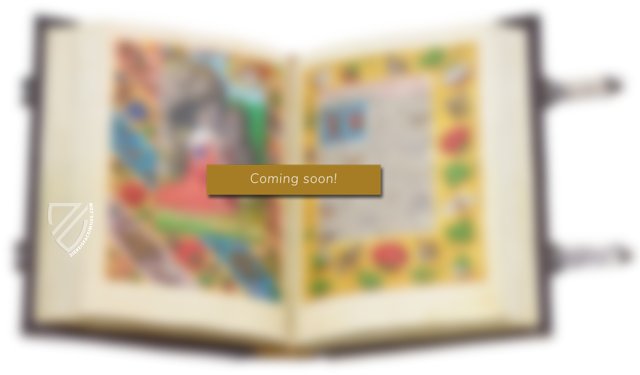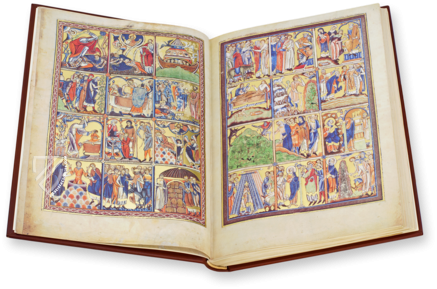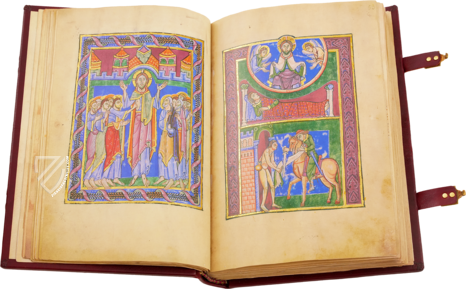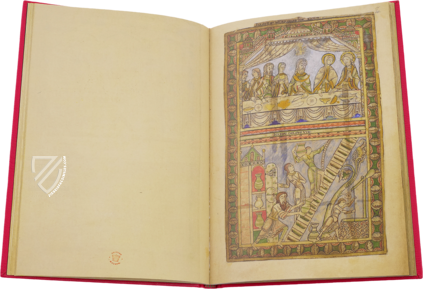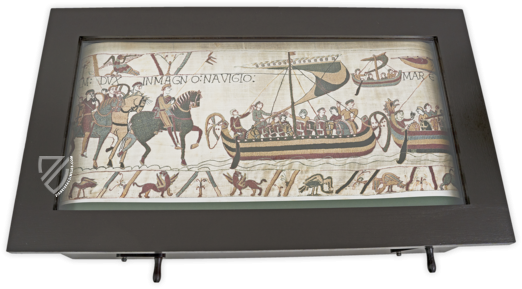Paris Psalter
(under 1,000€)
Created during the mid-11th century in England, possibly Wessex, the Paris Psalter is distinguished from other Psalters because it is an unusually tall and thin codex that incorporates 13 pen and ink drawings in the text, which is also adorned by blue, green, and golden initials. The text is written in two columns: the left column has the Latin text of the Psalter with the first fifty Psalms paraphrased in West-Saxon prose while the rest of the Psalms are translated into a metrical form of Anglo-Saxon. The West-Saxon translation is traditionally attributed to King Alfred the Great and the Psalter’s prose and poetic vernacular was influential and widely studied throughout England. In 1402, the coveted manuscript was listed in the inventory of the library of the famous bibliophile Duke Jean de Berry.
Paris Psalter
An unusual manuscript in an unusually elongated format measuring 52.6 x 18.6 cm: this famous and unique dual-language Psalter was originally made for a Benedictine Abbey, probably a women’s cloister, which is unusual because most Psalters were made for the use of the laity. The Latin text according to the Roman Rite appears in the left columns and the Anglo-Saxon translation in the right columns. This bilingual text represents the first real translation of the original Latin of the Book of Psalms, rather than merely representing a gloss with Old English corresponding word for word with the original Latin text.
The Work of Alfred the Great?
An inscription on the last page of the text informs us that “Wulfwinus (and according to an interlinear interjection “that is, by the surname Cadas”) wrote down this Psalter song of the famous King David, the priest of God. Whoever reads what is written, let his soul make a wish.” However, this scribe was not the original translator. According to the William of Malmesbury (ca. 1095 – ca. 1143), the principal historian in 12th century England, the text was originally translated by Alfred the Great (848/849–899), the learned King of the English and great foe of the Vikings, but this claim remains contested. Nonetheless, the Paris Psalter not only represents a fascinating unicum of late Anglo-Saxon book art but also a priceless artifact of the English language.
Fascinating Imagery Interwoven in the Text
The 13 pen and ink drawings that are integrated into the text of the first seven Psalms are remarkably detailed, artistically refined, and possess a certain charm. They obviously originated from a skilled, yet anonymous hand and the reason why the rest of the manuscript was not furnished with them remains unknown. Some of these images are typical of what one would expect, such as Christ emerging from the clouds above four terrified men and a man with a chalice leading a goat to a sacrificial altar. Other images are more unusual or imaginative including one showing the hand of God holding a pair of compasses or a man shooting arrows at a pair of lovers.
History of Ownership
This highly coveted manuscript was one of many owned by the famous bibliophile Duke John of Berry (1340–1416). Although first few centuries of the manuscript’s history remain unknown, as does under what circumstances it came to France, an ex-libris on fol. 186 states simply “This book belongs to the Duc de Berry, Jehan” and an entry in inventory of the Librairie du Duc de Berry dated August 17, 1402 reads: “Item a very old Psalter, long, with a history of Roman work and at the beginning of David playing the harp and on the fueilletz painted with arms of France and of Boulogne, covered with old silk…” The manuscript was part of the donation made by the Duke to the Sainte-Chapelle of Bourges by letters patent of 1404, and a 1552 inventory from there identifies it as the Psalterium Davidis and was identified once more in 1708 as “The Hours of Duke Jean” when it was still at Sainte-Chapelle in Bourges.
In 1752, the manuscript was donated by the canons of Bourges to the Bibliothèque du Roi, the inventory of which notes the receipt on the 8th of August that year of “A long fol. vol. containing the two-column Psalter comprising the Latin version and an Anglo- Saxon version:” It was probably at this point that the codex was rebound because the front and back covers of the 18th century binding are painted with the French royal coat-of-arms and cipher. Additionally, PSALTERI ANGLOSAXONICUM is printed in gold on the spine along with tendrils incorporating fleurs-de-lys and crowns. Today the manuscript is stored in the successor institution of the Bibliothèque du Roi, the Bibliothèque nationale de France.
Codicology
- Alternative Titles
- Paris-Psalter
Psalterium duplex, latinum et anglo-saxonicum
Latin 8824 - Size / Format
- 374 pages / 52.6 × 18.6 cm
- Origin
- United Kingdom
- Date
- Second half of the 11th century
- Epochs
- Style
- Genre
- Language
- Script
- Carolingian minuscule
- Illustrations
- 13 pen drawings; Large golden initials at the beginning of the psalms and hymns; Small golden, blue and green initials at the beginning of each verse
- Artist / School
- Wulfwinus (scribe)
#1 The Paris Psalter
(under 1,000€)
- Treatises / Secular Books
- Apocalypses / Beatus
- Astronomy / Astrology
- Bestiaries
- Bibles / Gospels
- Chronicles / History / Law
- Geography / Maps
- Saints' Lives
- Islam / Oriental
- Judaism / Hebrew
- Single Leaf Collections
- Leonardo da Vinci
- Literature / Poetry
- Liturgical Manuscripts
- Medicine / Botany / Alchemy
- Music
- Mythology / Prophecies
- Psalters
- Other Religious Books
- Games / Hunting
- Private Devotion Books
- Other Genres
- Afghanistan
- Armenia
- Austria
- Belgium
- Belize
- Bosnia and Herzegovina
- China
- Colombia
- Costa Rica
- Croatia
- Cyprus
- Czech Republic
- Denmark
- Egypt
- El Salvador
- Ethiopia
- France
- Germany
- Greece
- Guatemala
- Honduras
- Hungary
- India
- Iran
- Iraq
- Israel
- Italy
- Japan
- Jordan
- Kazakhstan
- Kyrgyzstan
- Lebanon
- Liechtenstein
- Luxembourg
- Mexico
- Morocco
- Netherlands
- Palestine
- Panama
- Peru
- Poland
- Portugal
- Romania
- Russia
- Serbia
- Spain
- Sri Lanka
- Sweden
- Switzerland
- Syria
- Tajikistan
- Turkey
- Turkmenistan
- Ukraine
- United Kingdom
- United States
- Uzbekistan
- Vatican City
- A. Oosthoek, van Holkema & Warendorf
- Aboca Museum
- Ajuntament de Valencia
- Akademie Verlag
- Akademische Druck- u. Verlagsanstalt (ADEVA)
- Aldo Ausilio Editore - Bottega d’Erasmo
- Alecto Historical Editions
- Alkuin Verlag
- Almqvist & Wiksell
- Amilcare Pizzi
- Andreas & Andreas Verlagsbuchhandlung
- Archa 90
- Archiv Verlag
- Archivi Edizioni
- Arnold Verlag
- ARS
- Ars Magna
- ArtCodex
- AyN Ediciones
- Azimuth Editions
- Badenia Verlag
- Bärenreiter-Verlag
- Belser Verlag
- Belser Verlag / WK Wertkontor
- Benziger Verlag
- Bernardinum Wydawnictwo
- BiblioGemma
- Biblioteca Apostolica Vaticana (Vaticanstadt, Vaticanstadt)
- Bibliotheca Palatina Faksimile Verlag
- Bibliotheca Rara
- Boydell & Brewer
- Bramante Edizioni
- Bredius Genootschap
- Brepols Publishers
- British Library
- C. Weckesser
- Caixa Catalunya
- Canesi
- CAPSA, Ars Scriptoria
- Caratzas Brothers, Publishers
- Carus Verlag
- Casamassima Libri
- Centrum Cartographie Verlag GmbH
- Chavane Verlag
- Christian Brandstätter Verlag
- Circulo Cientifico
- Club Bibliófilo Versol
- Club du Livre
- CM Editores
- Collegium Graphicum
- Collezione Apocrifa Da Vinci
- Comissão Nacional para as Comemorações dos Descobrimentos Portugueses
- Coron Verlag
- Corvina
- CTHS
- D. S. Brewer
- Damon
- De Agostini/UTET
- De Nederlandsche Boekhandel
- De Schutter
- Deuschle & Stemmle
- Deutscher Verlag für Kunstwissenschaft
- DIAMM
- Droz
- E. Schreiber Graphische Kunstanstalten
- Ediciones Boreal
- Ediciones Grial
- Ediclube
- Edições Inapa
- Edilan
- Editalia
- Edition Deuschle
- Edition Georg Popp
- Edition Leipzig
- Edition Libri Illustri
- Editiones Reales Sitios S. L.
- Éditions de l'Oiseau Lyre
- Editions Medicina Rara
- Editorial Casariego
- Editorial Mintzoa
- Editrice Antenore
- Editrice Velar
- Edizioni Edison
- Egeria, S.L.
- Eikon Editores
- Electa
- Emery Walker Limited
- Enciclopèdia Catalana
- Eos-Verlag
- Ephesus Publishing
- Ernst Battenberg
- Eugrammia Press
- Extraordinary Editions
- Fackelverlag
- Facsimila Art & Edition
- Facsimile Editions Ltd.
- Facsimilia Art & Edition Ebert KG
- Faksimile Verlag
- Feuermann Verlag
- Folger Shakespeare Library
- Franco Cosimo Panini Editore
- Friedrich Wittig Verlag
- Fundación Hullera Vasco-Leonesa
- G. Braziller
- Gabriele Mazzotta Editore
- Gebr. Mann Verlag
- Gesellschaft für graphische Industrie
- Getty Research Institute
- Giovanni Domenico de Rossi
- Giunti Editore
- Graffiti
- Grafica European Center of Fine Arts
- Guido Pressler
- Guillermo Blazquez
- Gustav Kiepenheuer
- H. N. Abrams
- Harrassowitz
- Harvard University Press
- Helikon
- Hendrickson Publishers
- Henning Oppermann
- Herder Verlag
- Hes & De Graaf Publishers
- Hoepli
- Holbein-Verlag
- Houghton Library
- Hugo Schmidt Verlag
- Idion Verlag
- Il Bulino, edizioni d'arte
- ILte
- Imago
- Insel Verlag
- Insel-Verlag Anton Kippenberger
- Instituto de Estudios Altoaragoneses
- Instituto Nacional de Antropología e Historia
- Introligatornia Budnik Jerzy
- Istituto dell'Enciclopedia Italiana - Treccani
- Istituto Ellenico di Studi Bizantini e Postbizantini
- Istituto Geografico De Agostini
- Istituto Poligrafico e Zecca dello Stato
- Italarte Art Establishments
- Jan Thorbecke Verlag
- Johnson Reprint Corporation
- Josef Stocker
- Josef Stocker-Schmid
- Jugoslavija
- Karl W. Hiersemann
- Kasper Straube
- Kaydeda Ediciones
- Kindler Verlag / Coron Verlag
- Kodansha International Ltd.
- Konrad Kölbl Verlag
- Kurt Wolff Verlag
- La Liberia dello Stato
- La Linea Editrice
- La Meta Editore
- Lambert Schneider
- Landeskreditbank Baden-Württemberg
- Leo S. Olschki
- Les Incunables
- Liber Artis
- Library of Congress
- Libreria Musicale Italiana
- Lichtdruck
- Lito Immagine Editore
- Lumen Artis
- Lund Humphries
- M. Moleiro Editor
- Maison des Sciences de l'homme et de la société de Poitiers
- Manuscriptum
- Martinus Nijhoff
- Maruzen-Yushodo Co. Ltd.
- MASA
- Massada Publishers
- McGraw-Hill
- Metropolitan Museum of Art
- Militos
- Millennium Liber
- Müller & Schindler
- Nahar - Stavit
- Nahar and Steimatzky
- National Library of Wales
- Neri Pozza
- Nova Charta
- Oceanum Verlag
- Odeon
- Orbis Mediaevalis
- Orbis Pictus
- Österreichische Staatsdruckerei
- Oxford University Press
- Pageant Books
- Parzellers Buchverlag
- Patrimonio Ediciones
- Pattloch Verlag
- PIAF
- Pieper Verlag
- Plon-Nourrit et cie
- Poligrafiche Bolis
- Presses Universitaires de Strasbourg
- Prestel Verlag
- Princeton University Press
- Prisma Verlag
- Priuli & Verlucca, editori
- Pro Sport Verlag
- Propyläen Verlag
- Pytheas Books
- Quaternio Verlag Luzern
- Reales Sitios
- Recht-Verlag
- Reichert Verlag
- Reichsdruckerei
- Reprint Verlag
- Riehn & Reusch
- Roberto Vattori Editore
- Rosenkilde and Bagger
- Roxburghe Club
- Salerno Editrice
- Saltellus Press
- Sandoz
- Sarajevo Svjetlost
- Schöck ArtPrint Kft.
- Schulsinger Brothers
- Scolar Press
- Scrinium
- Scripta Maneant
- Scriptorium
- Shazar
- Siloé, arte y bibliofilia
- SISMEL - Edizioni del Galluzzo
- Sociedad Mexicana de Antropología
- Société des Bibliophiles & Iconophiles de Belgique
- Soncin Publishing
- Sorli Ediciones
- Stainer and Bell
- Studer
- Styria Verlag
- Sumptibus Pragopress
- Szegedi Tudomànyegyetem
- Taberna Libraria
- Tarshish Books
- Taschen
- Tempus Libri
- Testimonio Compañía Editorial
- Thames and Hudson
- The Clear Vue Publishing Partnership Limited
- The Facsimile Codex
- The Folio Society
- The Marquess of Normanby
- The Richard III and Yorkist History Trust
- Tip.Le.Co
- TouchArt
- TREC Publishing House
- TRI Publishing Co.
- Trident Editore
- Tuliba Collection
- Typis Regiae Officinae Polygraphicae
- Union Verlag Berlin
- Universidad de Granada
- University of California Press
- University of Chicago Press
- Urs Graf
- Vallecchi
- Van Wijnen
- VCH, Acta Humaniora
- VDI Verlag
- VEB Deutscher Verlag für Musik
- Verlag Anton Pustet / Andreas Verlag
- Verlag Bibliophile Drucke Josef Stocker
- Verlag der Münchner Drucke
- Verlag für Regionalgeschichte
- Verlag Styria
- Vicent Garcia Editores
- W. Turnowski Ltd.
- W. Turnowsky
- Waanders Printers
- Wiener Mechitharisten-Congregation (Wien, Österreich)
- Wissenschaftliche Buchgesellschaft
- Wissenschaftliche Verlagsgesellschaft
- Wydawnictwo Dolnoslaskie
- Xuntanza Editorial
- Zakład Narodowy
- Zollikofer AG


